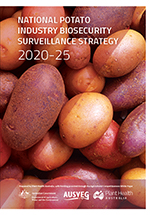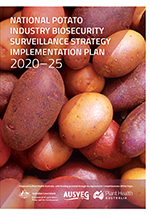
AUSVEG represents the biosecurity interests of vegetable and potato producers and the industry. They are members of Plant Health Australia and signatories to the Emergency Plant Pest Response Deed. Their responsibilities include:
- biosecurity planning and implementation at the national and farm levels
- liaising with federal and state governments on trade issues
- funding and supporting biosecurity initiatives
- participating in national committees and response efforts in an emergency.
Industry overview
Australia’s diverse climate and soils accommodate vegetable cultivation in all states and territories, ensuring a constant supply of fresh vegetables. Australian growers provide the majority of fresh vegetables consumed in Australia, and an increasing amount of fresh vegetables are consumed overseas.
The Australian vegetable industry is committed to building its capacity to respond to potential biosecurity threats. The employment of two full-time biosecurity officers, a tomato potato psyllid national coordinator and a potato pest surveillance officer allows the industry to participate in a range of biosecurity related initiatives.
Pests Expand
Exotic pests (not in Australia)
The following is a list of high priority exotic pests of potatoes. These pests were identified during the development of the Biosecurity Plan for the Potato Industry in consultation with industry, government and scientists. They have been assessed as high priority pests based on their potential to enter, establish, and spread in Australia (eg environmental factors, host range, vectors) and the cost to industry of control measures.
PHA has a range of fact sheets, contingency plans and diagnostic protocols relevant to these pests. Pest risk review documents are also available for some pests. Please contact PHA on 02 6215 7700 or email biosecurity@phau.com.au for more information.
Endorsed National Diagnostic Protocols are available from the National Plant Biosecurity Diagnostic Network webpage.
| Common name | Scientific name | EPPRD Category | Fact sheet | Contingency plan | Diagnostic protocol |
|---|---|---|---|---|---|
| American serpentine leaf miner | Liriomyza trifolii | FS FS FS | CP | DP | |
| Bacterial wilt | Ralstonia solanacearum, race 4 (exotic strains) | ||||
| Black bean aphid | Aphis fabae | FS | CP CP | ||
| CLso | Zebra chip | Candidatus Liberibacter solanacearum | 2 | FS FS | CP | DP |
| Colorado potato beetle | Leptinotarsa decemlineata | 3 | FS | DP | |
| Cotton aphid | Aphis gossypii (exotic strains) | FS | |||
| Potato cyst nematode (golden) | Globodera rostochiensis (exotic strains) | 3 | |||
| Potato cyst nematode (white or pale) | Globodera pallida | FS | |||
| Potato late blight (exotic strains) | Phytophthora infestans (A2 mating type and exotic strains of A1 mating type) | FS | |||
| Potato spindle tuber viroid | Potato spindle tuber viroid (Pospiviroidae) (exotic strains) | 3 | FS | DP | |
| Root knot nematode | Meloidogyne enterolobii syn. Meloidogyne mayaguensis | FS | |||
| Tomato-potato psyllid | Bactericera cockerelli | 3 | FS FS | CP | DP |
| Vegetable leaf miner | Liriomyza sativae | 3 | FS FS FS FS FS FS FS | CP |
Other pests
The following is a list of documents for other exotic and endemic pests of potatoes. Please note that this is not a complete list of pests: rather it includes pests for which documents exist in the Pest Information Document Database.
Some of the documents presented here are not tailored to the potato industry and are included for information only.
| Common name | Scientific name | EPPRD Category | Fact sheet | Contingency plan | Diagnostic protocol |
|---|---|---|---|---|---|
| Bacterial ring rot | Clavibacter michiganensis subsp. sepedonicus | 3 | FS | ||
| Cotton aphid | Aphis gossypii (exotic strains) | FS | |||
| Florida flower thrips | Frankliniella bispinosa | FS | |||
| Impatiens necrotic ringspot virus | Impatiens necrotic ringspot virus (Tospovirus) | CP | |||
| Papaya mealy bug | Paracoccus marginatus | FS | CP | ||
| Serpentine leaf miner | Liriomyza huidobrensis | FS FS FS FS | CP | ||
| Root knot nematode | Meloidogyne enterolobii syn. Meloidogyne mayaguensis | FS | |||
| Tarnished plant bug | Lygus lineolaris | FS FS FS | CP | ||
| Tomato black ring virus | Tomato black ring virus (Nepovirus) | FS | |||
| Tomato leaf miner (Tuta absoluta) | Tuta absoluta | FS | |||
| Verticillium wilt | Verticillium dahliae (exotic defoliating strains) | 3 | FS |
Surveillance
Expand
 National Potato Industry Biosecurity Surveillance Strategy
National Potato Industry Biosecurity Surveillance Strategy
The National Potato Industry Biosecurity Surveillance Strategy 2020–25 (NPIBSS) provides a framework for peak potato industry bodies and governments to identify and coordinate national surveillance priorities and activities.
The strategy will support surveillance and ensure the potato industry is informed, resilient, engaged and globally competitive. Improving surveillance will provide valuable information to improve the response to exotic pest incursions, support domestic and international market access, and improve pest management.
Strategy implementation plan
The NPIBSS Implementation Plan 2020–25 details how the strategy will be implemented, including the importance of strong support from stakeholders, governance arrangements, and secure funding arrangements.
Implementation of the NPIBSS will improve engagement and communication, identify and reduce barriers to undertaking surveillance and reporting of new pests and promote national capture, sharing and consistency of surveillance data to improve efficiency in biosecurity management within and between industry and governments.
Biosecurity plans, manuals and resources
Expand
 Industry biosecurity plans
Industry biosecurity plans
Biosecurity planning provides a mechanism for the vegetable industry, government and other relevant stakeholders to assess current biosecurity practices and future biosecurity needs. Planning identifies procedures that can be put in place to reduce the chance of pests reaching our borders or minimise the impact if a pest incursion occurs.
The Biosecurity Plan for the Potato Industry outlines key threats to the industry, risk mitigation plans, identification and categorisation of exotic pests and contingency plans. For a copy, please contact PHA on 02 6215 7700 or email biosecurity@phau.com.au
 Farm biosecurity manuals
Farm biosecurity manuals
Manuals usually contain an overview of biosecurity, fact sheets to identify the high priority pests of a crop, tips on crop management, and how to manage people, vehicles and equipment to minimise biosecurity risks. Manuals also contain a biosecurity self-assessment list, and templates to record pest surveillance records and visitors.
The Potato Growers' Biosecurity Manual is based on the six 'essentials ' of on-farm biosecurity: people, vehicles and equipment; farm inputs; farm outputs; feral animals and weeds; production practices; train, plan and record.
More information about on-farm biosecurity is available from the Farm Biosecurity website.





Recent Comments